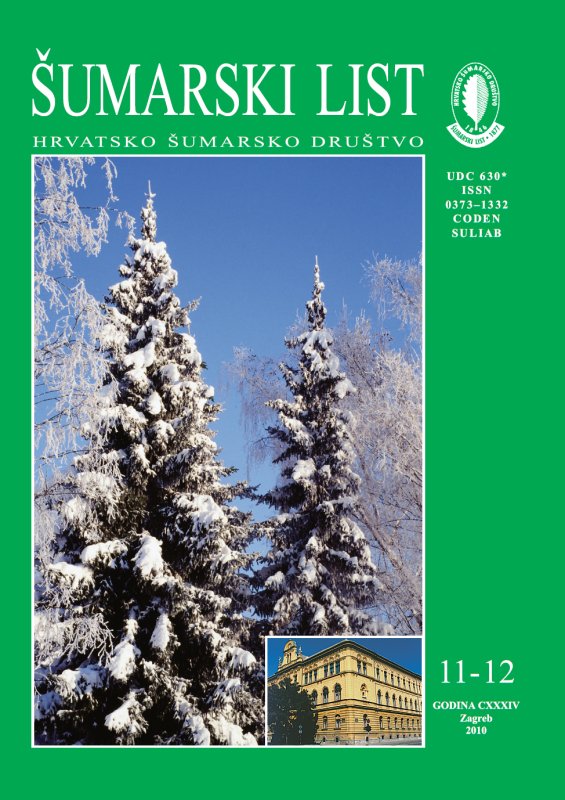
broj: 11-12/2010
pdf (7,55 MB) |
|
||||||||||||||
| RIJEČ GLAVNOGA UREDNIKA | ||
| Branimir Prpić | ||
| AT THE END OF THE YEAR pdf HR EN | 557 | |
| IZVORNI ZNANSTVENI ČLANCI | ||
| Vukelić, J., A. Alegro, V. Šegota, I. Šapić | UDK 630* 188 + 174.7 (001) | |
| Nomenclatural-Phytocoenological revision of the Association Calamagrostio variae-Piceetum dinaricum Bertović 1975, nom. illeg. in Croatia pdf HR EN | 559 | |
| Zebec, M., M. Idžojtić, I. Poljak, I. Mihaldinec | UDK 630* 164 (001) | |
| The Variability of Field Elm (Ulmus minor Mill. sensu latissimo) in Croatian Drava River Valley According to the Leaf Morphology pdf HR EN | 569 | |
| Cojzer, M., R. Brus | UDK 630* 182 (001) | |
| Species Composition and Successional Pathways on Abandoned Agricultural Land in Haloze pdf HR EN | 581 | |
| PRETHODNO PRIOPĆENJE | ||
| Cetl, V., B. Barišić, I. Šarušić | UDK 630* 582 | |
| Transfer of Cadastral data into the New State Coordinate System HTRS96/TM pdf HR EN | 593 | |
| Summary: Cadastral data play important role in many fields directly or indirectly associated with their use (land surveying, architecture and urban planning, civil engineering, agronomy, forestry, transport, tourism, etc.). In forestry cadastral data mostly are used to manage forest land through the planning, protection, conservation and sustainable development. In past 10 years there are significant changes in legislation concerning the official spatial data which are also reflected on the cadastral data. Certainly two of the most important changes are the introduction of new geodetic datum and map projection, and also transition to real estate cadastre. These processes for a wide range of users will induce new investments in the transformation of existing, or acquisition of new related maps in the new datum and projection if they want to be overlaid with the cadastral data. Except the transformation to new datum and projection, in the process of transition from land cadastre to real estate cadastre it is necessary to conduct homogenization. This process is needed after transformation, for cadastral municipalities with older cadastral surveys conducted with graphical method. This process is required for solving poor cadastral plan geometric accuracyrelated to graphical method technical limitations. Homogenization is defined with identical points collected by the usage of Digital OrtoPhoto in scale 1:5000 (DOP5). Since Croatia is on the beginning of this kind of works, this paper examines the transformation methods of cadastral data and the optimal selection of identical point’s density on the sample of cadastral district Brckovljani (Figure 1). The transformations of cadastral data were performed by the national GRID model transformation and 7-parameter transformation (Table 1). For transformations control purposes, coordinates of 4 trigonometric points measured with CROPOS system (directly in new datum with specified precision of 2 cm) are used. Statistical values for the GRID transformation meet the expectations (Table 2, left), and some improvements in 7-parameter transformation (Table 2, right) could be expected if locally estimated parameters will be used. However, main problems with the local parameters are extra efforts for their district level estimation and related complications with continuity of transformations on district borders. The GRID transformation model, after it become official, seems like appropriate solution. In the process of homogenization basic principle for the selection of an identical point is its stability since the time of cadastral survey. Most of the cadastral plans (approximately 75%) are created by surveys older than 100 years, so this principle is very difficult to meet. Before the selection of identical points, 200 x 200 meters grid was constructed to support their easier selection and regular distribution. Selection is performed in 3 different densities overlaying DOP5 (density I – 0,16 IP/ha, density II – 0,07 IP/ha and density III – 0,02 IP/ha). For the control of identical point’s density impact on the final results of homogenization, set of 44 control points is used. The situation with geometry of the cadastral plan before homogenization could be seen in Figure 3 and Table 3. Impact of identical point’s density is evaluated comparing statistics on control points before homogenization (Table 3, right), and after this process (Table 4). Only the densest set of identical points (0,16 IP/ha) has statistical indicators better after than before homogenization. Density has crucial impact on the costs of the homogenization process but on this example it is easy to see that savings in this segment could degrade geometry of cadastral plan which is unacceptable. Key words: cadastre; digital cadastral map; homogenization; HTRS96/TM; transformation | ||
| PREGLEDNI ČLANCI | ||
| Kovácsová, P., M. Antalová | UDK 630* 589 | |
| Precision Forestry – Definition and Technologies pdf HR EN | 603 | |
| Landekić, Matija | UDK 630* 302 + 384 | |
| Organizational Culture and Occupational Safety in the Croatian Forestry Sector pdf HR EN | 613 | |
| Balenović, I., H. Marjanović, M. Benko | UDK 630* 569 + 587 | |
| Application of Aerial Photographs in Forest Management in Croatia pdf HR EN | 623 | |


